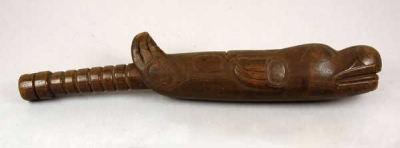Seal club (1940.7.0412)
 CanadaSeal club from Canada, Americas. Collector not known. Lent by Rchard C. Lowndes of the Four Counties Scout Training Station, Oxford in 1940.
CanadaSeal club from Canada, Americas. Collector not known. Lent by Rchard C. Lowndes of the Four Counties Scout Training Station, Oxford in 1940.
This wooden club is carved in the form of a seal or a sea lion and was used by the Haida people of Haida Gwaii (Queen Charlotte Islands), an archipelago off the coast of British Columbia, Canada's westernmost province. Although it only came to the Museum in 1940, it is probably much older than this.
There is no doubt that this is a hunting weapon. However, there is some uncertainty about the intended prey and concurrently, the meaning of the carved animal representation. The documentation accompanying the club states that it was used for killing seals and, 'in accordance with custom', was carved to represent its particular quarry. Certainly, seals were valuable to the Haida as sources of food, fat and skin for making clothing and shelters.
There is another interpretation, prompted by the observations of the great early anthropologist Franz Boas (1858-1942). In 1896 Boas wrote: "the fish club...is used for dispatching halibut and other fish before they are hauled into the canoe. Almost all of the clubs that I have seen represent the sea lion or the killer whale, the two sea animals which are most feared by the Indians, and which kill those animals that are to be killed by means of the club." Fish was a staple of the Haida diet so success in fishing was vital. In this way, we can see that a fish-club in the form of a sea lion may represent an animate ally and protector of the Haida hunter and may in fact increase the weapon's efficiency in its task.





